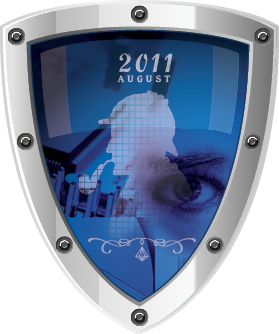Layers Of Protection
August 20, 11
When it comes to security and protection in the diamond and jewelry world, no one is more aware of the need for safety than Elie Ribacoff. The head of Worldwide Security Network (WSN) provides security solutions and consulting to the diamond and jewelry industry – to jewelers, jewelry wholesalers, their facilities and their traveling sales representatives. IDEX Magazine finds out about the latest technology helping diamantaiers and retailers to keep their eye on their goods and prevent unnecessary losses from occurring.
If there is one point that Elie Ribacoff tends to emphasize, it’s layers: layers of protection, layers of security, layers of vigilance. The former diamantaire, who had the chilling experience of seeing his father being brutally attacked and robbed as they arrived to open up the family business one morning, is concise with his advice to jewelers and diamantaires in how they can protect themselves – this advice essentially distills into this simple mantra: be proactive, not reactive.
For Ribacoff, a New York native, the need to be proactive filters down into every aspect of protecting a business, from ensuring that security systems are up-to-date and as advanced as possible, to making certain that businesses’ are adequately covered from an insurance perspective.
With the increase in materials prices, especially metals prices, which have increased tremendously over the past few years, some businesses are underestimating the worth of their inventory, he says, which could lead to problems should a robbery, burglary or other loss take place. Insurance companies will only pay out based on the amount stated in the policy even if it worth a greater amount.
 |
When it comes to jewelry-related crime in general, Ribacoff says that the industry faces the same risks as any other business, although there is the added threat of organized South American gangs, which are active throughout the world. In addition, he says, there is possibly a slightly higher risk of a terror threat in the diamond and jewelry business since so many businesses are run or employed by Jews.
He also says that with increased means of communication, organized crime is becoming much more international. “The thieves are much more sophisticated and able to track people to a greater level than previously.”
To ensure that the correct security systems are in place, Ribacoff recommends that jewelers and diamantaires upgrade their existing services rather than relying on a system that is a few years old and not as effective as those currently on the market. “We typically change our cell phones once a year and our computer every couple of years, the same should be true of security systems. Video cameras are much better today and with HDTV, they provide much more information. Now, instead of just relying on one camera, many people are opting to have a camera over every workspace. This means that there is always a record of what was on the desk and shows what may have been stolen or even accidentally thrown away,” he explains.
Before completely overhauling all their security systems, Ribacoff also recommends that companies implement and effective set of policies and procedures to ensure that safety always comes first. Staff and salespeople should be educated on how to adequately handle inventory, for example, while companies should also make sure they have something as basic as an emergency plan in place so that if they need to evacuate the building in case of an alarm, they can do so safely while still securing their merchandise.
Such procedures are all well and good while people are protected by the security of walls, doors and windows, but, says Ribacoff, one of the main problems is when people travel with merchandise. “They are no longer protected. They are unarmed and unescorted, and that’s where the dangers start,” he says.
As part of its services, WSN advises its clients about how to travel safely and how to avoid unnecessary exposure that could put them in danger. “We have never had a client sustain a loss who has been under cover with us,” he says proudly, “They are very proactive. We are aware of their travel plans; we know what they are doing and we advise them about what they have to do in order to make the trip safely.”
The company also offers a range of products to ensure not only protection against crime, but also protection against human error. One such product, launched in 2008, is the Security Track case. This, says Ribacoff, is a combination of a portable safe that will protect merchandise on the road. “It is similar to an armoured car,” he says, “but it is carried, not driven.” The case contains a locator device so that in the event the case is lost or stolen, a GPS signal is used to help track it down. “This technology is very widespread, we have just taken it and miniaturized it,” Ribacoff explains.
 |
This year, WSN added another product that can be used both to prevent theft, but also to ensure that simple human error does not cost a company in terms of working hours. The latest offering is a microchip that works according to RFI, radio frequency tagging, and that can be attached to any item, be it a diamond, ring or package. If the item is in a room or area equipped with a series of antennas, it can be tracked, and its whereabouts automatically known at all times. “You can place the chip on every item, even on the same label as the bar code. The information contained on the chip is broadcast through the office to antennas that are strategically placed every 12 to 15 feet.”
The technology that the microchip uses is compatible with all existing software systems. Since the antennas can read 1,100 tags per second, it speeds up the inventory system considerably since the items no longer have to be uploaded one piece at a time.
The system also tracks exactly where a stone is at any particular time, ensuring that no more hours are lost looking for misplaced items. “Typically, when a diamond is lost, everyone stops work and looks for it – a situation that can quickly add up in terms of lost productivity. Using this system, the readers can be put into emergency mode. Once you type in what you are looking for, the readers are all activated and are able to tell where the item last was and where it is now,” says Ribacoff. “The system is inexpensive, easy to install and the return on investment is almost immediate,” he promises.
Once again, he stresses, that this is not new technology. It has long been in use at companies such as Wal-Mart, for example. What WSN has done is miniaturize it so that it can be used in the jewelry industry. “With the current economic situation, it makes sense to embrace technology to enhance your capabilities to do more with fewer people. If you put a security guard on every person, there wouldn’t be any losses. People are fallible. This is just like an extra seatbelt or airbag.”
Almost ironically, Ribacoff says that far from decreasing spending on security, the recent recession actually led to an increase in security spending. “I think it is because jewelers and diamantaires realize that the value of their inventory has increased.”
Another reason he cites is that while the downturn forced many companies to downsize and to move into smaller premises in a bid to reduce costs, they made sure to equip the new places with higher security. “They are now more secured per square foot,” he says. Perhaps it is because insurance companies made them do it, no matter the reason, they are better protected.”